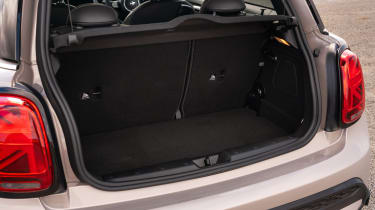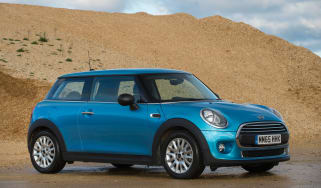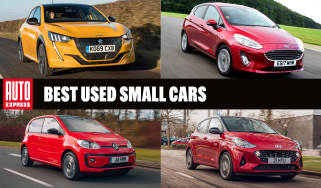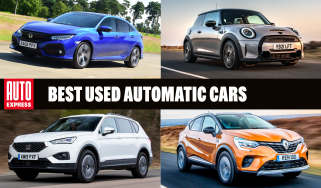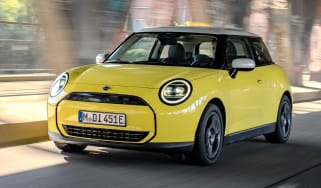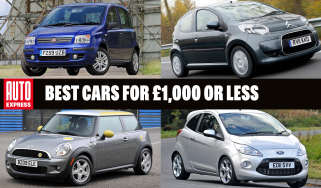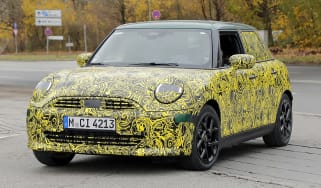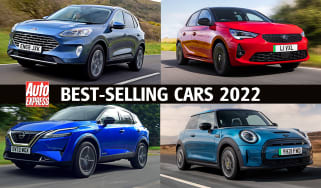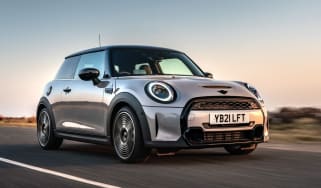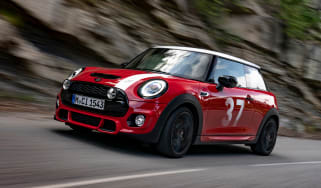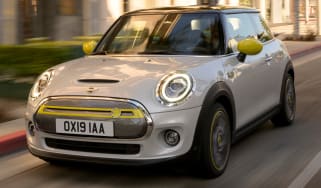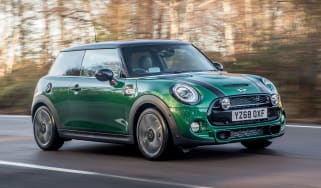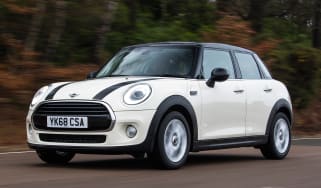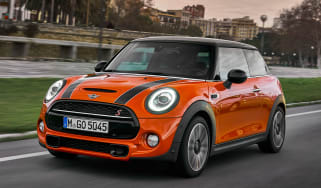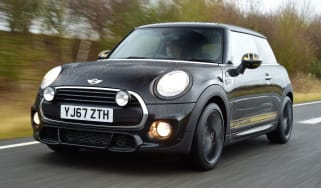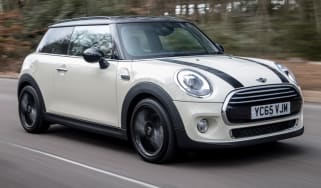MINI hatchback review
The stylish MINI hatchback is full of quality and driver appeal that few rivals can match
It might be getting bigger with each new generation, but the MINI is also getting better, to the extent that now it truly feels like a cut-size BMW. It's also an award winner, having scooped the Convertible of the Year title at our 2022 awards.
A key part of the MINI's appeal is the myriad personalisation options available, but while it’s possible to spec a bespoke MINI that’s eye-wateringly expensive, regardless of engine, most versions are actually very well priced if you buy with restraint. Thanks to the five-door version, which retains the character of the three-door but adds more space, it’s passable family transport, too.
About the MINI hatchback
The MINI is an upmarket and fashionable hatchback that combines attractive retro styling with a great driving experience. Its rivals include similarly upmarket offerings like the Audi A1 and Volkswagen Polo, along with more conventional superminis like the SEAT Ibiza, Mazda 2, Ford Fiesta and Citroen C3. To some extent, the Fiat 500 and its Abarth relative also stand as retro-styled competition, but these are much smaller.
While the MINI for sale today apes the style of its classic 1960s predecessor, and has similar go-kart-like handling , it’s much, much bigger – especially in five-door or Clubman estate guise. In fact, the latest ‘new’ MINI is the third generation built by BMW, and is itself a little bigger than the last.
Introduced in 2014, the MINI Mk3 is longer, wider, and has a slightly longer wheelbase than its predecessor, which improves accommodation for rear passengers and luggage space. An all-new fourth-generation model is due in 2023, but for now there is the choice of three and five-door versions, along with the practical MINI Clubman estate, a MINI Convertible, the sporty John Cooper Works hot hatch and an SUV/crossover known as the MINI Countryman. There’s a plug-in hybrid Countryman model and the MINI all-electric hatchback, too.
In early 2018 the current generation MINI received a mid-life update and benefitted from tweaked styling, more technology and equipment added as standard, and offered more ways for customers to personalise their cars. These MINIs are recognisable by the single-ring LED daytime light graphic, full-LED headlights (with a matrix anti-dazzling function, available optionally) and rear lights with a Union Flag design.
There was a further light refresh in early 2021, with revisions including a bigger grille, with a body-coloured strip through the centre and a new black surround, as well as air inlets replacing the previous spot lamps in the lower section of the front bumper. The inside trim around the headlights is now finished in black rather than chrome.
Interior changes added a new 8.8-inch colour touchscreen, along with sporty black trim in place of the older car's chrome flourishes. A new sports steering wheel and a five-inch digital instrument display are also now standard across the range.
MINI introduced a new range of turbocharged engines for the third-generation model, shared with the BMW 1 Series and the X1 crossover. The familiar 1.5-litre MINI One is no longer offered on the price list, although the more powerful 1.5-litre Cooper, sporty 2.0-litre Cooper S and the full-blown hot hatch John Cooper Works versions are still available.
MINI now offers four style specifications: Classic, Sport, Exclusive and Resolute. The entry-level Classic is basic but reasonably well-equipped; a traditional looking MINI and a blank canvas for your imagination to run wild on the options list. Opt for Sport and you'll benefit from additional John Cooper Works embellishments such as an aerodynamic kit, a rear spoiler and sports seats.
The Exclusive brings an air of luxury, with plenty of leather and chrome details, while the Resolute Edition model is based on the Exclusive trim and features Rebel Green solid paintwork.
Inside, the MINI gets a raft of technology, and it's safer, better equipped and more sophisticated than ever. Don't get too carried away with the options list and the MINI hatch will generally prove to be a cost-effective car to run, too, so you needn't break the bank to put one on your drive.
Engines, performance and drive
BMW has rung the ‘go-kart handling’ message dry since taking on the MINI brand in 2001, but it remains a very apt way to describe the driving experience. The latest MINI is one of the most all-out fun cars to drive at any price, with safe, predictable handling, near zero body roll and lots of feel through the seat and steering wheel.
Combined with its low-slung driving position and near-enough perfect ergonomics, the MINI is usually a smile-inducing experience. But that’s ‘usually’ because the ride quality can be firm, especially at lower speeds or on bad roads.
The ride quality is noticeably better than that of previous generation MINIs, but the car doesn’t have the sophisticated balance of bump-soaking comfort and handling feel that, say, a Ford Fiesta has.
It gets better or worse depending on wheel choice, so it’s up to you whether you want to choose the looks of 17- or 18-inch wheels from the options list, or the relative comfort of small-looking 15-inch wheels. Logically, 16-inch rims tend to be a nice compromise between the two.
The sports suspension on Cooper S and JCW stiffens and lowers the car noticeably, though optional adaptive dampers help because they let you toggle between a comfort and sports setting – pricey though they are.
The MINI isn’t usually uncomfortable, however. It’s nicely settled at motorway speeds, while the relative lack of wind and road noise makes it feel like a very grown-up small car. Factor in strong acceleration with most models (basic One variants aside), and this is a surprisingly relaxing long-distance cruiser.
Of all the engines it’s the three-cylinder petrol Cooper that shines brightest, because it’s quick and very eager to be revved – but not so powerful that it races to unnecessary or unmanageable speeds. It really suits the character of the car, and it sounds great.
Although lacking the terrific sound of the three-pot model, the MINI Electric brings the benefits of instant acceleration, cheap running costs and silent running. It actually rides quite nicely and is more comfortable than you might expect, especially if you’re moving to electric ownership from an older MINI.
The longer five-door petrol model feels no different to the three-door MINI from the front seat, with extra space between front and rear wheels having little discernible effect on handling – this is a car that cocoons the driver, in the positive sense.
0-62mph acceleration and top speed
With the 101bhp 1.5-litre MINI One no longer available, there are three petrol engines to choose from: the Cooper gets a 134bhp version of the same engine, the Cooper S has a 2.0-litre four-cylinder engine with 176bhp, while the JCW model, also a 2.0-litre, is boosted further to 228bhp.
If you do track down a used example of the MINI One, you'll find it pretty lethargic - in fact it's slightly slower off the mark than the old 1.2-litre model with a 10.3-second 0-62mph sprint time (10.6 seconds in the five-door).
The 1.5-litre petrol in the Cooper really does shine, though. With 134bhp and 220Nm of torque from just 1,480rpm it’s quite strong from low revs, but the real magic is at the top end of the rev range. It sounds raspy and pulls strongly, with 0-62mph coming in 8.0s, or 8.3s in the five-door owing to its extra bulk.
The Cooper S engine perhaps loses some charm on account of being a four-cylinder, but it’s very quick, with a 6.8/6.9-second sprint to 62mph (three-door/five-door) and a more fiery tone from the twin central exhaust pipes. And then the JCW engine, a highly tuned version of the Cooper S unit, is positively rip-roaring, racing up the rev range, popping and cracking all the way.
MPG, CO2 and running costs
The MINI has always been quite fuel efficient, but this generation’s range of engines improves things considerably. Although now discontinued, MINI claims the entry-level 1.5-litre One model is capable of returning a maximum 52.3mpg, with CO2 emissions from 122g/km. However, given the extra performance on offer it’s remarkable that the more powerful 1.5-litre engine in the Cooper is only marginally worse – 51.4mpg and 125g/km of CO2.
With its extra performance, the Cooper S naturally isn't as economical as the Cooper – 48.7mpg and CO2 of 133g/km – and even more so with the John Cooper Works model which returns 42.8mpg and emits 151g/km.
Specify any MINI with the optional MINI Driving Modes and you’ll be able to choose between Sport, Mid and Green settings. The system alters the parameters of the throttle, steering and air conditioning according to the mode selected. In Green mode it desensitises the accelerator pedal, makes the steering lighter and displays the most economical time to change gears, which can help to save fuel.
If you really want to save on fuel costs there's the MINI Electric which is able to cover around 140 miles on a single charge.
Insurance groups
The MINI’s desirability and BMW servicing costs mean it sits in higher insurance groupings than less ‘premium’ superminis like the Ford Fiesta. Starting in group 13 for a three-door One Classic, the range reaches into group 29 for the JCW model and group 37 for the JCW GP model. The MINI Electric occupies the middle ground in groups 22 to 23.
Depreciation
One benefit of the MINI’s carefully cultivated premium image is that desirability remains very high relative to its ubiquity on UK roads. Our experts predict that the three-door models will retain an average of 56 per cent of their value after three years and 36,000 miles, with the Cooper S Sport and Resolute Edition models the strongest performers on 60 per cent.
It's worth bearing in mind that decisions on colour and trim can affect MINI values, so choose wisely when you come to buy. Be wary of brighter colours and of loading your car with additional kit and accessories, some of which will add no value. Climate control, satellite navigation and fancier wheels are all options that add to a MINI’s appeal and value on the used market.
To get an accurate valuation on a specific model check out our free car valuation tool...
Interior, design and technology
Given the huge sales success of the first two generations of MINI, it’s no surprise that designers have played it safe with the latest car. In fact, at a glance it looks identical to the last one. But dedicated fans of the brand will notice the slightly more bulbous proportions and the larger front and rear lights.
The five-door model gets rear side doors with frames, rather than the three-door’s frameless ones, plus an extra 72mm between the front and rear wheels, and 89mm more at the very back to boost the boot. It’s not as pretty as the three-door – and, frankly, looks a bit of a mess if you take in the details for too long – but somehow it still works as a whole.
MINI has been bold as usual with the new car’s interior, and the eye-catching design still features plenty of retro touches. But there’s nothing retro about the driving position – as per the preceding two BMW-era MINIs, this one comes with a highly adjustable chair and steering wheel combo that ensures anyone can find a near perfect setup.
Much of the switchgear has been relocated compared to the outgoing model's interior layout. The familiar line-up of toggle switches is still on the centre console, but the window buttons are now on the doors, while a BMW-style iDrive controller sits between the front seats, replacing the old car’s joystick.
As with every MINI there’s huge scope for personalisation and myriad cost options, ensuring that you can at least feel like your MINI is unique – but it all soon adds up to one expensive MINI.
The Sport specification offers additional John Cooper Works enhancements such as an aero styling kit, a rear spoiler and sports seats, along with black exterior trim and 17-inch black alloy wheels. The top-spec Exclusive offers cruise control, sports seats and various unique styling upgrades over the standard Classic models. The Resolute limited edition is based on the Exclusive, but with Rebel Green solid paint, black and bronze exterior accents, bonnet stripes and unique badging.
The MINI Electric is offered in three individual 'Levels' of trim (along with a Resolute edition). Level 1 includes auto air conditioning, cruise control, the navigation pack and auto headlights. Upgrading to Level 2 brings power folding door mirrors, a rear-view camera and heated front seats, while Level 3 adds LED headlights, a Harman Kardon audio system, an enhanced nav system and a panoramic glass sunroof.
Sat-nav, stereo and infotainment
Dominating the dash is a large, circular display for the infotainment and optional sat-nav. In characteristic MINI style, its theatrical outer ring is illuminated and acts as an additional multi-colour display, mimicking various things including the speedometer, stereo volume, or flashing when the driver’s attention is required.
Based on BMW’s iDrive setup, the MINI’s infotainment is good. Following the light facelift in 2021, all cars now come with a larger 8.8-inch touchscreen unit, with sat-nav and Apple CarPlay connectivity.
Practicality, comfort and boot space
The new MINI is longer and wider than before, but the three-door feels barely any bigger inside. At least the front chairs tilt and slide forward to aid access, and up front there is plenty of space, with impressive headroom and improved shoulder room.
That means that while adults of most sizes will find a comfortable driving position, the trade-off when a taller person is driving (or is a passenger) is virtually nonexistent rear legroom
There are two gloveboxes (albeit the upper one is very small indeed), while nets on the seat backs and front passenger footwell give useful additional storage. The MINI still comes with a central armrest that can hide a mobile phone, but never fails to be in the way of your elbow, whether you have it up or down, and also obscures the iDrive controller between the seats.
Overall comfort is good in the MINI – though the seats themselves are on the smaller side, and combined with the MINI’s firm ride quality at lower speeds, it can feel harsh. The five-door model settles down well at a motorway cruise, however. Visibility is pretty good, despite the MINI’s letterbox windscreen.
Dimensions and size
The MINI’s apparent growth isn’t just a trick of design – in every direction the third generation car is bigger than its predecessor, which in turn was bigger than the 2001 model, which in turn dwarfed the 1959 original. In modern context, at 3.8m long, the three-door MINI is significantly longer and wider than a Volkswagen Up.
The five-door even more so, naturally, measuring in at almost 2ft longer than the Volkswagen. That takes it out of the city car leagues of the original and firmly into modern supermini (Ford Fiesta etc.) territory.
Leg room, head room & passenger space
Up front it’s a much more comfortable tale in the MINI than in the back, regardless of how many doors there are. For a car small by definition, the space up front seems remarkable – a 7ft person would have adequate head- and legroom, largely on account of how low the seats are set – a benefit of the ‘go kart’ brief.
The three-door offers a very cramped rear section, but the five-door is another story – what a difference a few millimetres makes. There’s noticeably more rear legroom – and it makes all the difference when taller people are up front. It basically makes the rear seats useable in a circumstance where they simply wouldn’t be in the three-door MINI.
Boot space
The boot space is better than ever, up 30 per cent over the last MINI’s to 211 litres. And the five-door’s is better still, with its 278-litre space measuring up well against rivals like the Ford Fiesta (290 litres).
A twin-floor boot is standard, which is useful in raising the loading level to the lip of the rear hatch, making loading and unloading easier – or for keeping items of luggage separate from one another. It nearly clips up onto the back of the rear seats when not in use, too.
Reliability and safety
The newest MINI scored four stars in a 2014 round of Euro NCAP crash tests, which is mildly disappointing when most new cars these days so often achieve a full five-star rating. A 79 percent score for adult occupants and 73 percent for child occupants are perhaps what you’d expect of a small car – but way behind the 84 percent and 85 percent ratings respectively for the BMW 2 Series Active Tourer that’s based on the same chassis (and was tested at the same time).
The MINI’s worst Euro NCAP score was 56 percent for safety assistance systems, largely because newer technology like lane departure warning isn’t available at all, while low speed autonomous braking (city braking assistant) is optional, as is a head-up display and automatic cruise control. The MINI does have two Isofix points as standard, however.
For impact protection it features high-strength steel in the body, impact absorbers and a pop-up bonnet to help improve a pedestrian’s chance of survival if struck. Electronic stability control (which can be switched off), anti-lock brakes and tyre pressure monitoring are all standard.
The MINI hatch finished in an impressive 11th place (out of 75 cars) in the 2022 Driver Power survey, while MINI itself achieved 9th spot (out of 29 brands) in the manufacturer poll.
Warranty
The MINI comes with a three-year/60,000-mile warranty, covering the usual gamut of mechanical and electrical parts – not including those subject to normal wear and tear. Beyond that, MINI offers a very similar service to BMW (unsurprisingly), called MINI Insured Warranty, available to any car under 100,000 miles. It can be purchased as either an extension to the standard warranty, or for specific components, like the clutch, engine or gearbox.
Servicing
MINI offers its Service Inclusive scheme which, for a fixed price, will cover scheduled maintenance for petrol and PHEV models for up to five years (four years for the MINI Electric). Alternatively, monthly payment plans are also available from around £18 per month for petrol models and £10 per month for the Electric hatch.
Used and nearly new
Launched in 2001, the classy MINI hatchback has lost little of its desirability over the years and is still a strong used buy. Now in its third generation, buyers will find plenty of models on the market, although be prepared to do your homework before committing to a purchase, as the variety of engine and trim combinations and myriad special editions can be a little confusing. Reliability is good, though, and there is the option of economical diesel engines or more powerful petrol units.
MINI hatchback history
MINI hatchback Mk3: 2014-date
The third-generation MINI hatch is a bigger car than its predecessor and has received some criticism for its enlarged dimensions and front- and rear-end styling. It's still unmistakably a MINI, however, and offers the usual premium air, efficient engines and a striking interior.
We'd recommend a petrol Cooper model with a six-speed manual gearbox, although there are two diesel versions available: the 95bhp One D and 116bhp Cooper D. Buyers looking for a more dynamic drive will find the 192bhp Cooper S, or the more powerful 228bhp John Cooper Works (JCW) variants more appealing. Read our full Mk3 MINI hatchback buyer’s guide here…
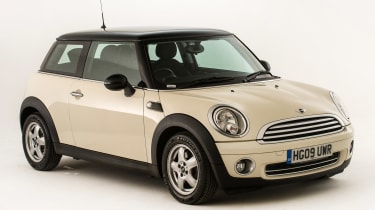
MINI hatchback Mk2: 2007-2014
You'll probably find that a Mk2 MINI will command a price premium over other superminis of similar age and mileage. Its blend of stylish good looks, decent engines and driving fun mean its hard to beat, even if you have to pay a little more for the privilege.
A facelifted model was introduced in 2010, bringing styling tweaks to the bumper design and changes to the exterior light clusters. Interior trim was upgraded, while a new 1.6-litre diesel engine was added to the range with 111bhp in Cooper guise. Read our full Mk2 MINI hatchback buyer’s guide here…
Other MINI hatchback models
MINI hatchback Mk1: 2001-2007
BMW struck gold in 2001 with its all-new MINI hatchback. Buyers were captivated by the retro-modern One and Cooper models, which also offered an impressive cabin and superb driving dynamics. The 163bhp Cooper S arrived in 2002, while the 200bhp Cooper S Works provided even more punch. Those looking for wind-in-the-hair motoring might want to seek out a Mk1 Convertible model, available from 2004 onwards.
